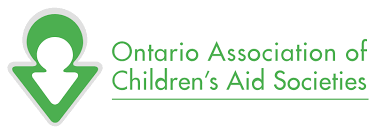Dress Purple Day
Dress Purple Day


Every October, Tikinagan Child and Family Services along with Children’s Aid Societies and Indigenous Child and Family Well-Being Agencies across the province, raise awareness about the important role that individuals and communities play in supporting vulnerable children, youth, and families. This includes every adult’s legal duty to call their local Children’s Aid Society or Indigenous Child and Family Well-Being Agency if they have a concern about the safety or well-being of a child or youth.
Dress Purple Day offers an opportunity to encourage everyone to speak up for every child and youth’s right to safety and well-being in all spaces. Not just physical safety and well-being—children and youth have the right to have their intersectional identity, which includes culture, race, sexual orientation, and gender identity, protected, and supported in all spaces.
We use this day to raise awareness that community organizations are part of the circle of care that supports the well-being of children, youth, and families. At Tikinagan, we refer to this circle as the Wee-chee-way-win Circle.
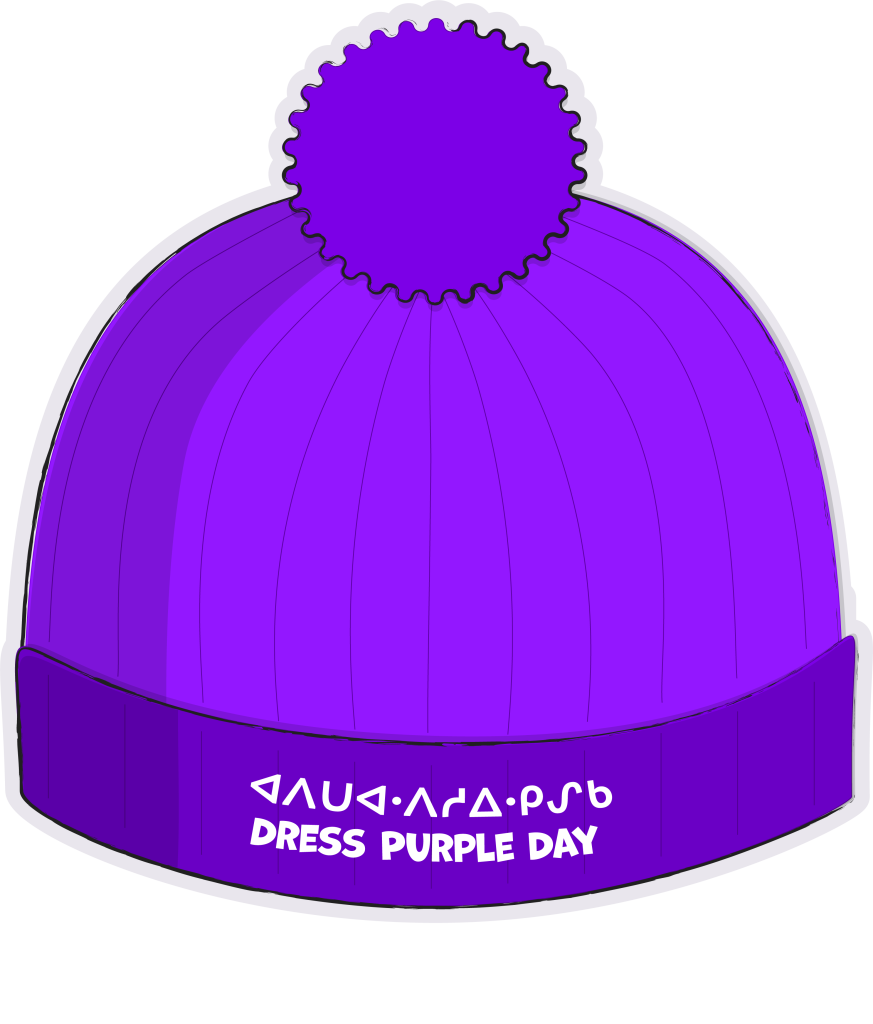
The Wee-chee-way-win Circle may include the child’s parents and siblings, extended family members, the First Nation Chief and Council, Elders, the school principal and teachers, workers from other community resources, Foster Parents, other caregivers, and Tikinagan workers. Although each has a different role in a child’s circle, the success of a child’s emotional security depends on teamwork. By working together in mutual cooperation and respect, a circle of healing will surround the child. The Wee-chee-way-win Circle is an integral element of Mamow Obiki-ahwahsoowin.
Mamow Obiki-ahwahsoowin, which means “Everyone working together to raise our children,” is the Tikinagan service model and works to keep families together, maintain our culture and respects the inherent authority of First Nations to care for our own children. Mamow Obiki-ahwahsoowin is rooted in our traditional customs of caring for children. In our culture, children are regarded as sacred gifts from the Creator, not only to the family but also to the larger community of extended family members. Everyone shares in the responsibility of protecting and caring for that child.
On Dress Purple Day, we celebrate a community that cares for families and share the message that help is available and no one is alone.
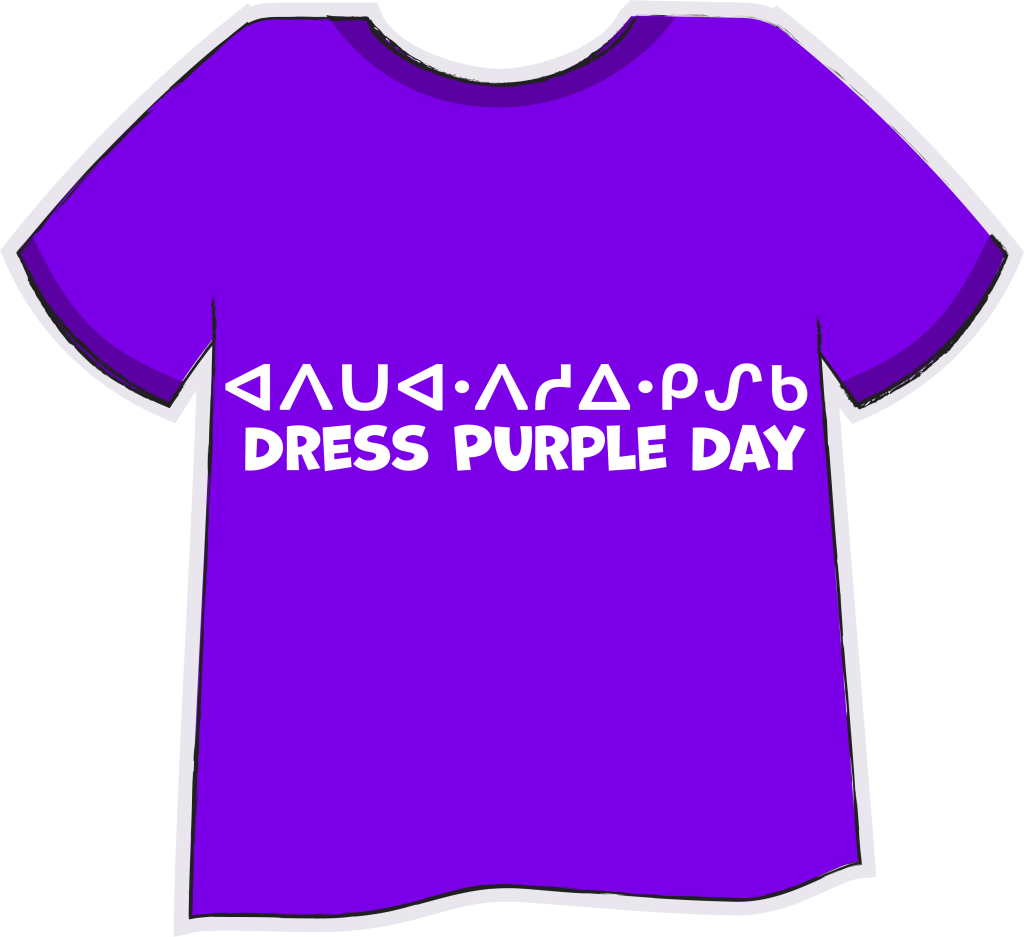
We are calling on everyone to wear something purple on October 27 to show children, youth, and families that they are here to help!
Show your support on social media by posting your purple pictures with the hashtags #IDressPurpleBecause and #IDressPurple
Dress Purple Day is important to our organization. It gives us the opportunity to show our communities that we are here for our children, youth, and families as a resource. Our philosophy, Mamow Obiki-ahwahsoowin, doesn’t just include Tikinagan staff. It includes the whole community as we all work together to raise our children. We really hope to see everyone wearing purple as a way to show that they are part of the circle of care.
I Know My Rights
Dress Purple Contests

Wear Purple. Win a Hot Lunch!
Every class that has 10 or more students wearing purple will win a hot lunch. We ask that teachers send pictures of their class, with the teacher’s name, classroom grade and school name to communications@tikinagan.org. The pictures will be shared on Tikinagan’s social media as well as other materials. A consent form is attached, if needed.
Student Contest! Win a Nintendo Switch!
Every student from Tikinagan’s 30 First Nation is invited to participate in our Student Contest. Students are asked to write, draw, or express in some art form why they dress purple. All submissions will receive a $25 gift card, and the Top 3 entries will WIN a Nintendo Switch! We ask teachers submit art with the teacher’s and student’s name, grade and school/community to communications@tikinagan.org. The pictures will be shared on Tikinagan’s social media as well as other materials.
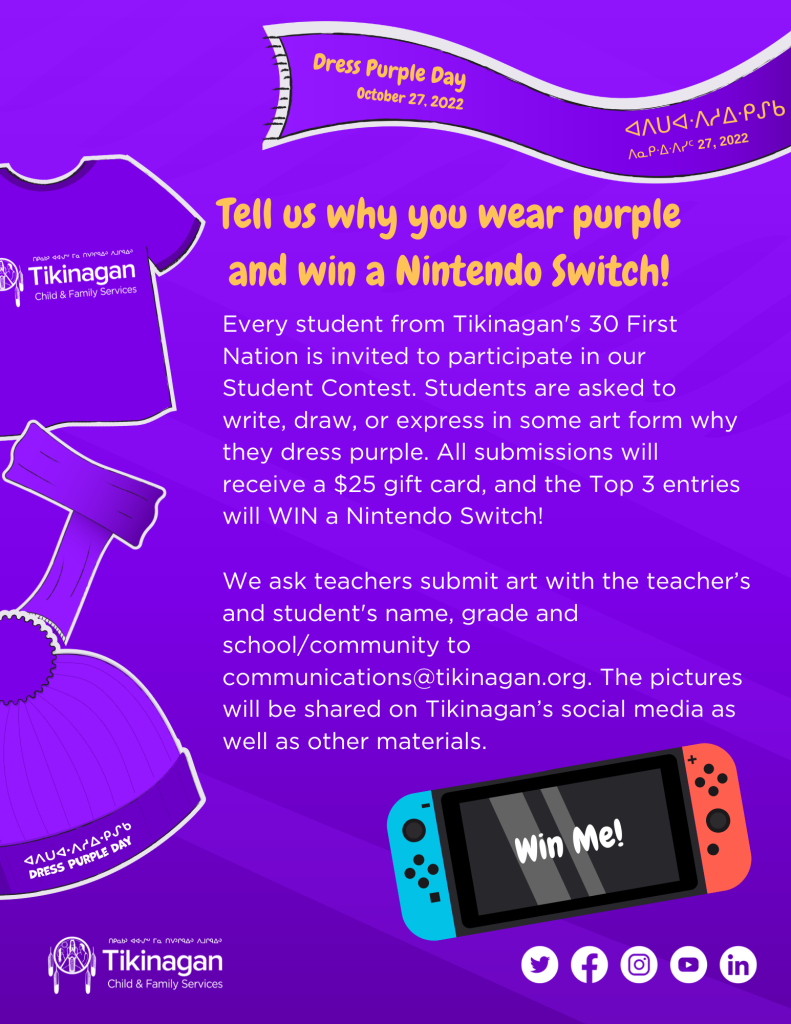
Classroom Resources
The intention of the classroom resources for elementary students is to support educators with tools and information to make Ontario Dress Purple Day a meaningful learning opportunity for students. The resources, which are based on the theme, “It takes a community to care for kids,” are intended to help education professionals engage children and youth in conversations about safety and well-being, helping adults in the community, and how to ask for help. The resources also incorporate an equity perspective that includes racism, prejudice, intolerance, and systems abuse as reasons why children and youth might need to ask for help.
The classroom resources for middle and high school students focus on self-esteem, healthy and unhealthy relationships, and the role of adults and social services in helping youth and their friends. The resources also incorporate an equity perspective that includes intolerance, prejudice, and discrimination as reasons why youth might need to ask for help. A youth’s well-being is damaged when their gender identity, race, ability, sexual orientation, culture, language, and religion is not respected, and when they encounter discrimination and prejudice at the individual level and at the institutional and systems level.
Research shows that older children and adolescents generally disclose to their peers, usually about maltreatment experiences involving same-age peers and not necessarily about maltreatment perpetrated by adults. Regardless of the type of abuse shared with peers, it is imperative to emphasize the necessity of adult involvement. Educating older children and adolescents around how to help their peers by asking for support from adults is an important piece in any personal safety or prevention program.
Elementary Students
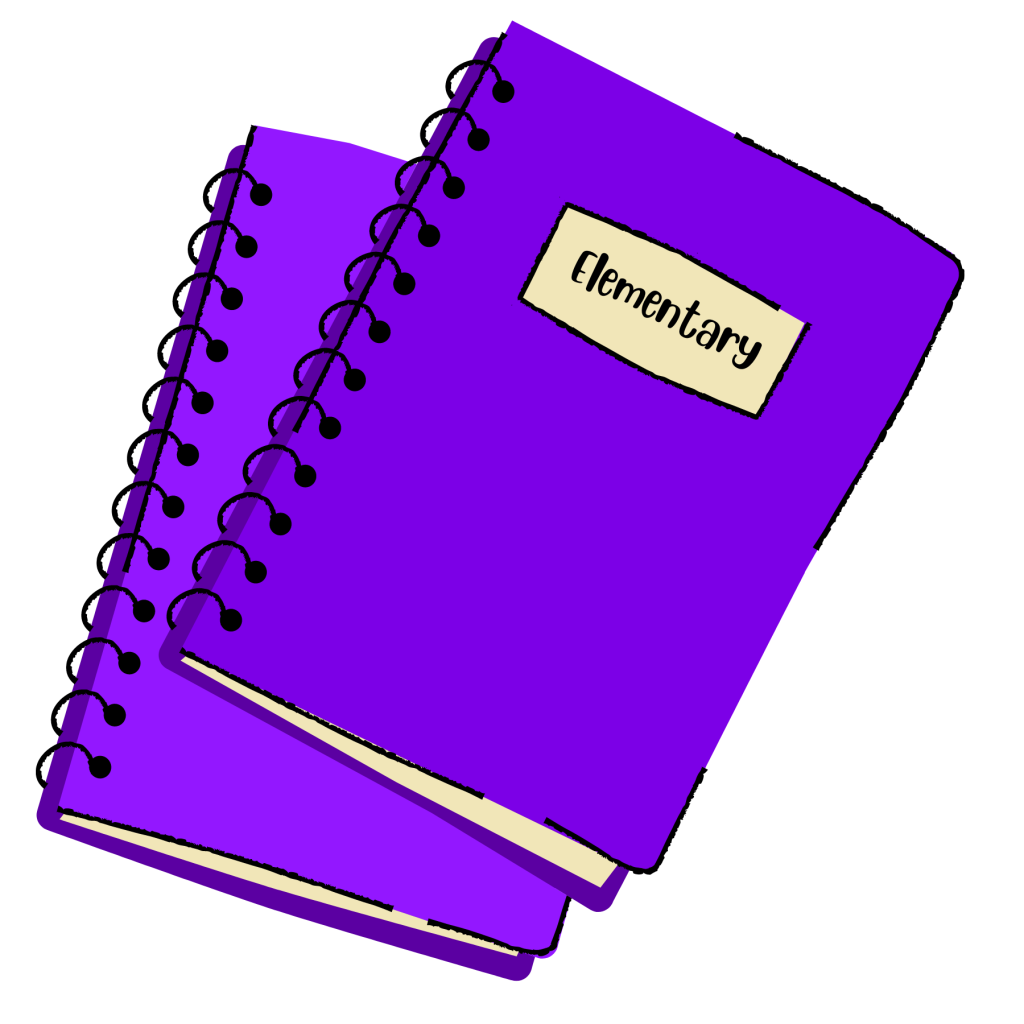
Lesson 1: “It Takes a Community to Care for Kids”
It is the responsibility of adults in the community to ensure children’s rights to safety and well-being, wherever they are. In this lesson, children identify adults in their community that they can turn to for help. They are also encouraged to keep telling until they get the help they need.
Lesson 2: “Safety in the Community”
Healthy touch is integral to human relationships and, as a result, children need practice becoming in tune with their feelings about touch. In this lesson, children will learn about how to recognize their “uh-oh” feeling and apply it to situations involving inappropriate touch. They will also learn that there are no secrets about touch.
Lesson 3: “Well-being in the Community”
The community is also responsible for ensuring the well-being of children. In this lesson, children learn that they have physical, emotional, social, and cognitive needs. They will also learn how to identify the adults in the community who can help them if these needs are unfulfilled.
Lesson 4: “Ontario Dress Purple Day: It Takes a Community to Care for Kids”
On Ontario Dress Purple Day children join communities across the province and speak up for their rights to safety and well-being and how it takes a community to care for kids. This lesson engages children in fun activities to bring to life this positive message that help is available. This lesson reviews the key themes presented in previous lessons.
Middle & High School Students

Lesson 1: “You are Not Alone – We Can Help”
Youth have a right to safety and well-being in all the spaces they occupy. When youth are in distress or experiencing maltreatment the most important thing for them to do is to get help. In this lesson, students learn about the role of trusted adults in supporting them when they need help, the barriers that may get in the way of help, and strategies and resources for getting help for themselves and their peers.
Lesson 2: “Self-Esteem”
A strong and positive sense of self-esteem can help youth cope with stress, seek out healthier relationships, and maintain boundaries. Youth with strong self-esteem are also more likely to reach out for help when their safety and well-being is at risk. This lesson looks at the different factors that can impact a youth’s self-esteem, including self-talk and relationships. This lesson also looks at how intolerance and prejudice can impact self-esteem.
Lesson 3: “Healthy and Unhealthy Relationships”
Relationships can be complex and confusing to navigate, and so the ability to establish clear boundaries and recognize when relationships are becoming unhealthy is an important skill. In this lesson, youth learn about the differences between healthy and unhealthy relationships, as well as strategies for maintaining healthy relationships, ending unhealthy relationships, and navigating the power dynamics within relationships. In this lesson respect for all people, regardless of their race, gender, sexual identity, culture, language, or religion, is shown to be key to healthy relationships.
Beastie Valley
Beastie Valley is an educational series brought to us by the Windsor-Essex Children’s Aid Society supported by the Ontario Association of Children’s Aid Societies. This series touches on subjects such as getting help and well-being in the community. These are great resources for the classroom and the home.
Lesson 1: Getting Help
How to find help and ask for help. The first person you go to might not be able to help, so this requires you to tell more than one person.
Getting Help tells the story of OrangeBeastie needing help with a problem – something embarrassing so they don’t want to share it with the whole world. After trying to solve their problem on their own, OrangeBeastie realizes they need to find someone they can trust to tell their problem to. Someone who can help or direct them to the help they need. They go through some options in their head before landing on PurpleBeastie, who had experience dealing with difficult situations.
In the end, OrangeBeastie got the help they needed and is doing much better coping with their problem and all thanks to their trusted friend and an adult beastie named SilverBeastie. [source]
Lesson 2: Getting Touchy
How different kinds of touch can make us feel, learning about boundaries & consent, and the importance of getting help from an adult.
Getting Touchy tells the story about RedBeastie who has REALLY ticklish head tendrils and is super self-conscious about it to boot. But they’re just so bouncy and blobby that most other folks can’t help themselves from reaching out and giving them a feel or a poke. This makes RedBeastie really uncomfortable. It reminds them of when their older cousin used to make fun of their sensitivity and would use them as little punching bags, which actually hurt a lot.
One day, RedBeastie meets a really nice beastie, GreenBeastie. They become fast pals and their friendship flourishes. There’s one problem though, RedBeastie is worried the same thing will happen with GreenBeastie. This leads to a lot of misunderstanding and hurt feelings which almost ends their friendship.
Thanks to some help from an older and wiser beastie named BurntSiennaBeastie, these beastie besties learn an important lesson together about consent and boundaries. AND in the end, they find a new and special way to celebrate their friendship! [source]
Lesson 3: Well Being in the Community
Understanding what wellbeing is all about and how we can make sure all of our needs are being met. Adults have a role to play.
Wellbeing in the community tells the story of one particular young beastie named MaroonBeastie. MaroonBeastie is pretty cool and well-liked. You’d think that would be enough for any beastie, but MaroonBeastie has one thing that they’re really really into and can’t get enough of. For as long as they can remember, MaroonBeastie has always been into treecones.
But lately, MaroonBeastie is feeling more and more like no matter how many cones they collect – and they’ve collected a LOT of treecones – it’s somehow never enough. Meanwhile, it seems like ALL the other beasties are carrying on with fulfilling lives.
MaroonBeastie’s journey leads them to encounter many beastie friends along the way, including an adult beastie named SepiaBeastie who knows a thing or two about a thing or two. SepiaBeastie teaches all the young beasties an important lesson about wellbeing, how important it is to have all our needs met, and how adult beasties can help.
MaroonBeastie finally understands this lesson and in the end, finds what they have been needing the most. [source]
Lesson 4: Getting Connected
Everyone in a community plays a role, and together create a strong community web. No one is alone.
Getting Connected brings together all the experiences and lessons from the Beastie Valley video series to show that Beastie Valley is a true community. Everyone does their best and wants what’s best for themselves and the other beasties. This act of sharing and support is happening all around Beastie Valley. Even if you can’t find help the first time you look for it, eventually you will, and a strong community web is one with lots of connections. That means you are not alone.
You can see how everyone is connected, you can see how you’re connected. And you can see how much stronger the web is because of – you! [source]
Duty to Report
The purpose of the Child, Youth and Family Services Act (CYFSA) is to promote the best interests, protection, and well-being of children and youth.
Section 125 of the Act states that a person, including professionals who work with children or youth, must promptly report any suspicions that a child or youth may be “in need of protection” to a Children’s Aid Societies or Indigenous Child and Family Well-Being Agencies, such as Tikinagan Child and Family Services.
Children and youth have a right to safety and well-being wherever they are. This includes not just in their homes, but also in their communities. Tikinagan will investigate concerns about primary caregivers but also community caregivers such as teachers and coaches.
The Child, Youth and Family Services Act recognizes that professionals and officials who work with children have an enhanced responsibility to report their suspicions.
Under the Child, Youth and Family Services Act, a professional’s failure to uphold their duty to report for a child under 16 could lead to a “penalty” or a fine of $5,000.
As of 2018, 16 and 17-year-olds are eligible to receive protection services from Children’s Aid Societies. While reporting for 16 and 17-year old youth is not mandatory, please contact Tikinagan if you have concerns about the safety or well-being of a youth.
You do not have to be sure about concerns to make a referral to a Tikinagan use your best judgement. Tikinagan has the expertise to assess and decide whether to intervene.
If you have a concern about the safety and well-being of a child or youth you must call Tikinagan at 1-800-465-3624. You are not permitted to delegate your legal duty to report to any other person, including a supervisor.
While confidentiality cannot be assured when making a referral, concerns about being identified should be shared with the Children’s Aid Societies or Indigenous Child and Family Well-Being Agencies. Privacy and confidentiality should not be seen as barriers to making a referral to Tikinagan.
The duty to report is ongoing. Even if you have made a previous referral, you must continue to make referrals if you believe a child or youth still requires protection.
Tikinagan may not be able to tell you details about how they are going to respond to your concerns, but may be able to provide a general overview of what will occur.
Share Your Purple Shirt Pic!
Share your purple shirt pics on social media using the hashtags:
#IDressPurple or #IDressPurpleBecause
Thank you to the Ontario Association of Children’s Aid Societies (OACAS) for support and content


